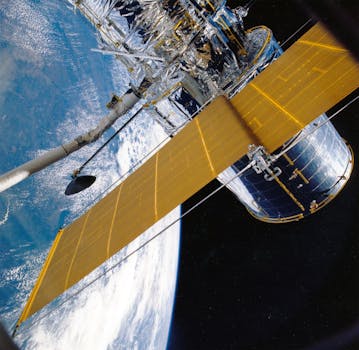
Focus Keyword: Satellite Technology. Recent advances in Satellite Technology are revolutionizing global communications, enabling faster and more reliable connectivity across the globe. The development of new satellite constellations, such as OneWeb and Starlink, is transforming the way we communicate, with implications for industries ranging from telecommunications to finance.
The use of satellites in communication is not new, but recent advances in technology have significantly improved the efficiency, cost, and capacity of satellite-based communication systems. Satellites in low Earth orbit (LEO) are being used to provide high-speed internet access to remote and underserved areas, while satellites in geostationary orbit (GEO) are being used for broadcast and telecommunications services.
One of the key drivers of the growth of the satellite industry is the increasing demand for global connectivity. As the world becomes increasingly interconnected, the need for reliable and efficient communication systems has never been greater. Satellite technology is playing a critical role in meeting this demand, with the global satellite market expected to reach $442 billion by 2027, up from $261 billion in 2020.
Advances in Satellite Technology
Several recent advances in satellite technology are driving the growth of the industry. These include the development of new satellite constellations, such as OneWeb and Starlink, which are designed to provide high-speed internet access to remote and underserved areas. These constellations are made up of hundreds of small satellites in LEO, which work together to provide a network of coverage around the world.
Another key advance is the development of new satellite propulsion systems, such as electric propulsion and advanced ion engines. These systems enable satellites to maneuver more efficiently and extend their lifespan, reducing the cost of satellite operations and increasing the overall efficiency of satellite-based communication systems.
The use of artificial intelligence (AI) and machine learning (ML) is also becoming increasingly important in the satellite industry. AI and ML are being used to optimize satellite operations, predict and prevent errors, and improve the overall efficiency of satellite-based communication systems.
Impact on Global Communications
The impact of recent advances in satellite technology on global communications is significant. Satellites are enabling faster and more reliable connectivity across the globe, with implications for industries ranging from telecommunications to finance. The use of satellites is also enabling the deployment of new communication services, such as 5G and IoT, which are critical to the growth of the digital economy.
The use of satellites is also having a major impact on the way we communicate in emergency situations. Satellites are being used to provide critical communication services in the aftermath of natural disasters, such as hurricanes and earthquakes, and are playing a key role in the response to the COVID-19 pandemic.
In addition, satellites are enabling the deployment of new communication services in remote and underserved areas. The use of satellites is providing access to high-speed internet, voice, and data services in areas where traditional communication infrastructure is lacking, and is helping to bridge the digital divide between urban and rural areas.
Challenges and Opportunities
Despite the many advances in satellite technology, there are still several challenges that need to be addressed. One of the key challenges is the issue of space debris, which is becoming an increasingly significant problem as the number of satellites in orbit grows. The use of satellites is also raising concerns about privacy and security, as well as the potential for interference with other communication systems.
However, the opportunities presented by recent advances in satellite technology far outweigh the challenges. The use of satellites is enabling the deployment of new communication services, and is playing a critical role in the growth of the digital economy. As the demand for global connectivity continues to grow, the role of satellites in meeting this demand will only continue to increase.
Conclusion
In conclusion, recent advances in satellite technology are revolutionizing global communications, enabling faster and more reliable connectivity across the globe. The development of new satellite constellations, such as OneWeb and Starlink, is transforming the way we communicate, with implications for industries ranging from telecommunications to finance.
As the demand for global connectivity continues to grow, the role of satellites in meeting this demand will only continue to increase. The opportunities presented by recent advances in satellite technology are significant, and it is likely that we will see even more innovative applications of satellite technology in the future.




